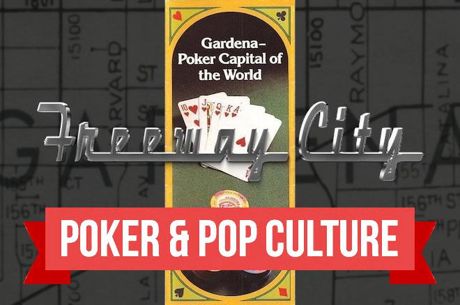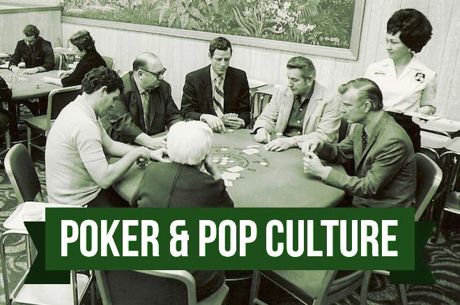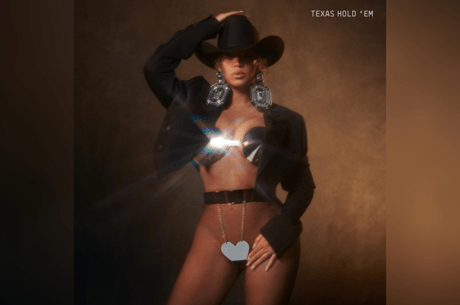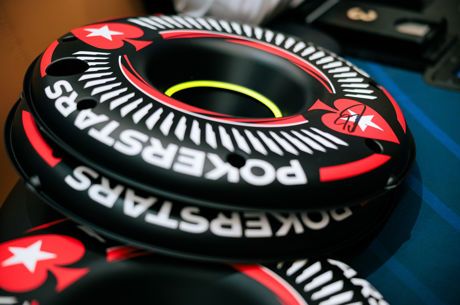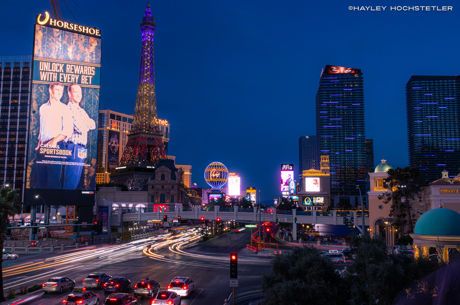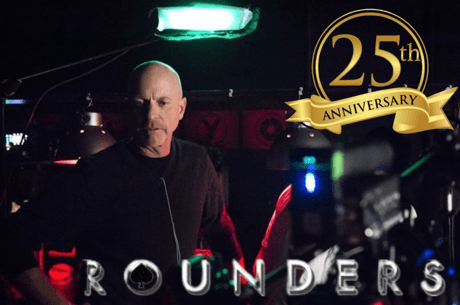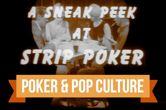Poker & Pop Culture: Moss and Dandolos at the Horseshoe - Legend or Myth?
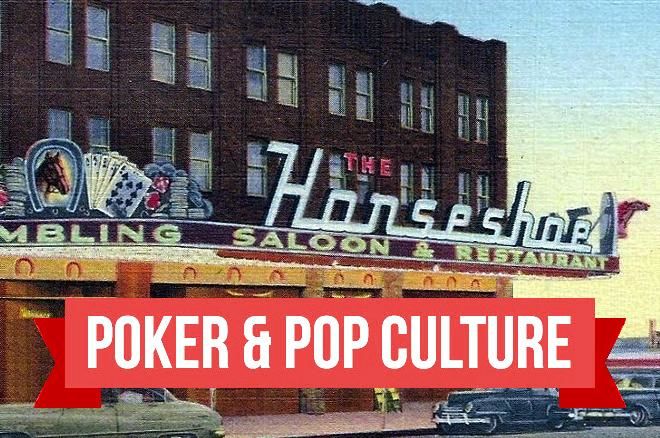
The 2017 World Series of Poker is just a week away, the 48th installment of the annual tournament series that has grown from a modest gathering of high rolling poker players into an international spectacle.
Last week we not only learned this summer's WSOP Main Event will no longer feature a delayed final table (a.k.a. the "November Nine"), but there will be more televised coverage of the Main Event starting with the first Day 1 flights. The latter news was met with enthusiasm by many, showing there remains a significant appetite for televised poker.
It wasn't that long ago, of course, that the idea of watching people play cards was a relative novelty. Poker on television (with hole cards) is still a somewhat recent development, with live streaming online even more so. Go back just a few decades, and it was even less prevalent of an idea. Strange seeming, even.
Looking for where it all might have started, many point back to a certain high-stakes, heads-up poker match between Johnny Moss and Nick "the Greek" Dandolos, a showdown arranged by Benny Binion to take place at his casino on Fremont Street. The legendary match between Moss and Dandolos would eventually become part of poker history and retrospectively identified as a kind of precursor to the World Series of Poker introduced at Binion's casino later in 1970.
The historical authenticity of the match has been much debated, but it has nonetheless endured as a much-referenced, influential episode in the development of professional or "legitimate" poker. It has also been held up by many as a quite literal example of poker being presented to a wider audience — of the game being made into a spectacle for the non-poker playing public to witness.
A Marathon Match, Played for Millions
Like most legends, the story of the Moss-Dandolos match is riddled with dubious details and (likely) extreme embellishments. Even the date is in doubt.
Most who have considered the matter closely tend to agree some sort of heads-up duel did occur between Moss, the established veteran of the Texas poker wars who'd go on to win nine WSOP bracelets, and Dandolos, the Crete-born, high-rolling gambler who'd made a fortune in banking and real estate and at the time was in search of the biggest games from coast to coast.
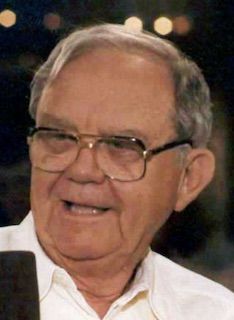
Benny Binion had arrived in Las Vegas in 1946, having essentially fled Dallas where a checkered past of bootlegging, theft, illegal gambling and other crimes (alleged and actual) had finally threatened to catch up with him. With a partner, Binion soon took over the Las Vegas Club, though Binion would eventually break with his partner and purchase the El Dorado on Fremont, renaming it the Horseshoe.
Soon thereafter — the story goes — Dandolos arrived in Vegas in search of "the biggest game this world can offer," and not so coincidentally found himself in touch with Binion, the new casino owner whose mark upon early Vegas was largely summed up by the sign he'd hung above the Horseshoe's front door: "THE WORLD'S HIGHEST LIMITS."
Binion could help Dandolos. The Horseshoe would be the perfect location for such a game, and Binion knew just the man to pit against the high-rolling action-seeker.
Binion phoned his longtime friend Moss back in Texas, convincing him to leave his current game and come to Vegas to play Dandolos with a bankroll provided by Binion. Moss arrived — probably in 1951 (although Moss himself once told a biographer it was 1949) — and soon he and Dandolos were engaged in what would become a lengthy heads-up poker match that included several variants of the game, with five-card stud said to be the most prominent.
Further details of the match can be found in numerous places, with most accounts tending to agree upon a few particulars.
The stakes were certainly high. Most versions describe a particular hand of five-card stud, won by Dandolos, in which the pot exceeded half a million dollars. In addition to the test of nerves potentially caused by the huge pots, the match was also a test of stamina, with the pair playing four and five days at a time without a break, and the entire match lasting several months.
Apparently tourists were occasionally permitted to take part as well, buying in for a minimum of $10,000, though those members of the game's supporting cast never stayed for very long. As we try to envision the scene, the climactic poker game in the 1965 film The Cincinnati Kid comes to mind, in which the story's hero Eric ("The Kid") is left to battle Lancey Howard ("The Man") after the game's other players all drop away.
Continuing with the accounts, Dandolos is said to have taken an early advantage, but ultimately Moss would end well ahead, and in most versions Moss is reported to have taken more than $2 million off his opponent.
The Lure of High Stakes (It Doesn't Take an Einstein to See)
A most intriguing aspect of the story — albeit one that is least possible to verify — is the way the Moss-Dandolos match attracted onlookers, a phenomenon Binion may or may not have anticipated.

Early on, Binion is said to have relocated the game to a more conspicuous place near the casino's front entrance where the gathering crowds would additionally draw foot traffic from those passing by the Horseshoe. Anthony Holden offers to describe the scene in his 1990 book Big Deal.
"The crowd stood six deep around the table, marveling at the nerve and stamina of these two poker titans, and at the vast amounts of money passing back and forth between them," writes Holden. "Binion's subsequent fortune was founded on the dollars these same spectators then poured into his casino's coffers," he adds.
"Their table was soon hemmed in by chattering flocks of railbirds two and three hundred strong," writes James McManus in Cowboys Full, further sketching the scene. "Noting how much the railbirds were wagering elsewhere in his casino, Binion called his new attraction 'the biggest game in town.'"
The game, in other words, had become a means to bolster business at the Horseshoe, with spectators inspired to try their luck at other house games after having gotten a taste from watching the high rollers play cards.
And Binion — so it is said — took full advantage. They weren't just drawing cards in this poker game, but drawing customers, too.
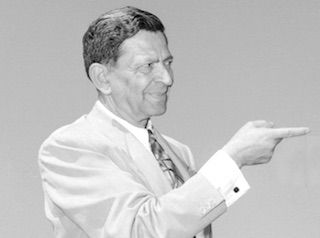
McManus shares another detail from the "legend of Johnny and the Greek," duly noting its doubtful authenticity. Amid the crowd of onlookers, a certain German-born, Nobel Prize-winning physicist who had relocated to the United States to live out his last years makes an appearance in this imagined tableau.
"During one break, while the railbirds headed off to the craps and blackjack tables, Dandolos allegedly chaperoned Albert Einstein along Fremont Street, introducing him to local gamblers as 'Little Al from Princeton — controls lotta the action 'round Jersey.'"
At some point, some four or five months after the game had begun (say most), Dandolos finally stood from his chair and said "Mr. Moss, I have to let you go," thereby cutting his losses and ending the epic encounter.
How the Biggest Game Went Down in History
In terms of cultural impact, while the benefits of the match were immediately apparent to the Horseshoe, its influence cannot reasonably be said to have extended much further for at least a couple of decades. Michael Craig (The Professor, The Banker, and the Suicide King) in particular has noted that no extensive accounts of the game appeared until the 1970s, not even in books devoted to the two participants.
Indeed, it really wasn't Al Alvarez included the story of the game in his 1983 classic The Biggest Game in Town that it began to receive widespread attention, ultimately being built into a seminal event in modern poker history.
Having spoken to Moss and Binion directly (along with several others), Alvarez narrates the story of the game while explictly drawing a link between the match and the latter WSOP.
"The World Series was first held in 1970," writes Alvarez, "but the idea of it originated in 1949" with the Moss-Dandolos match. After telling about the game, Alvarez segues back into WSOP history, writing how "in 1970, the Binions decided to restage a battle of the giants by inviting the top professionals to play in public."
Not everyone agrees the link between the earlier game and the idea for the WSOP. In his 2008 book Ghosts at the Table, Des Wilson, for one, flatly refutes the "scores of references" underscoring "the relationship between that game and the founding of the World Series of Poker."
"In my view it is a false assumption," says Wilson. "If the Horseshoe match took place, it did not inspire the launch of the World Series."
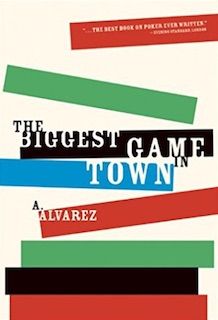
Speaking of Alvarez's account — and just to complicate things a little further — a few years ago I spoke with Jesse May, the poker commentator and author of the 1998 poker novel Shut Up and Deal. Among the topics we discussed was our mutual admiration for Alvarez's book, and May provided an interesting bit of background regarding it.
"Listen, I love The Biggest Game in Town... it's one of my favorite books," said May. "But it's a funny thing... [Alvarez] went out to Vegas and sat around met Benny Binnion and Moss and Amarillo Slim [Preston] and Puggy [Pearson] and basically whatever they told him, he just accepted as gospel as [though] that's the way it happened... [when in fact a lot of it] is about as far from the truth as possible!"
Having researched several of the stories related by others in Alvarez's book, May found a lot of examples of creative embellishment by the tale-tellers. Interestingly, the different witnesses were all more or less consistent with their stories and their details, including about the Moss-Dandolos match.
"The amazing thing about those guys is that they basically [all] got their stories straight," said May. "They knew that the reality was not for mass consumption. And [so] these stories were created and repeated with enough detail and by enough of them that they just became accepted as the truth. And maybe some of them even believe now that that's what actually happened, but it's not."
May added that he had spoken with Alvarez about this a couple of times, and his response was that it was "incredible" how all of those whom he interviewed for Biggest Game could have agreed on so many details of the stories — "especially stuff about Johnny Moss and Nick 'the Greek.'"
Shouldn't seem too surprising, really. After all, whether playing cards or telling stories about playing cards, poker players are notoriously good at bluffing.
Conclusion
Stepping back from it all, it could be argued that it doesn't matter too much what exactly happened at the Horseshoe in 1949 or 1951 or whenever, or even if a heads-up match between Moss and Dandolos attracting hundreds of onlookers even happened at all.
The idea of turning a game of poker into a kind of "spectator sport" was certainly part of the early history of the WSOP during those initial gatherings in the early 1970s, whether or not there had been an earlier example to provide a kind of inspiration for it.
And today that tradition has been well established, as many of us will no doubt follow with interest the coverage of this year's WSOP Main Event, not to mention the $300,000 buy-in Super High Roller Bowl coming next week — very much a modern-day version of the legendary (or, depending on your point of view, mythical) Moss-Dandolos match.
Editor's Note: For more on the story about the Moss-Dandolos match — including Jack Binion’s clarifications that it never really happened quite the way many have said — see "Poker & Pop Culture: Jack Binion Sorts Fact From Fiction Regarding Moss-Dandolos Match."
From the forthcoming "Poker & Pop Culture: Telling the Story of America's Favorite Card Game." Martin Harris teaches a course in "Poker in American Film and Culture" in the American Studies program at UNC-Charlotte.

